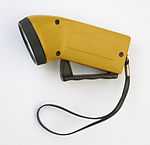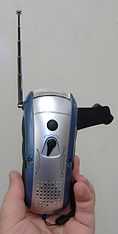Mechanically powered flashlight

A mechanically powered flashlight is a flashlight that is powered by electricity generated by the muscle power of the user, so it does not need replacement of batteries, or recharging from an electrical source. There are several types which use different operating mechanisms. They use different motions to generate the required power; such as squeezing a handle, winding a crank, or shaking the flashlight itself. These flashlights can also be distinguished by the technique used to store the energy: a spring,[2] a flywheel, a battery or a capacitor.
Since they are always ready for use, mechanically powered flashlights are often kept as emergency lights in case of power outages or other emergencies. They are also kept at vacation homes, cabins, and other remote locations because they are not limited by battery shelf life like ordinary flashlights. They are considered a green technology, because the disposable batteries used by ordinary flashlights are wasteful in terms of resources used for the amount of energy produced, and also contain heavy metals and toxic chemicals which end up in the environment.
Dyno torch



A dyno torch, dynamo torch or squeeze flashlight is a flashlight or pocket torch which stores energy in a flywheel. The user repeatedly squeezes a handle to spin a flywheel inside the flashlight, attached to a small dynamo, supplying electrical current to an incandescent bulb or light-emitting diode. The flashlight must be pumped continuously during use, with the flywheel turning the generator between squeezes to keep the light going continuously. Because electrical power is produced only when the handle is squeezed, a switch is not needed. Dyno torches were issued to soldiers during World War II, and were popular in Europe during the war because the electrical power supply to homes was not very reliable. A version using a pull-cord was used in World War 1.[1]
The photo at right shows the internal mechanism. The L-shaped handle has a gear rack, which spins the white step-up gear, which in turn spins the flywheel on which is mounted the dark grey magnet, seen on the lower left. The magnet induces an electrical current in the red copper winding, seen on the lower right. The current from the copper winding flows through the filament of an incandescent light bulb (not shown), giving off light. A spring and ratchet returns the handle to its original position after each engagement.
Shake type design

The linear induction or Faraday flashlight or "shake flashlight" is another design of a mechanically powered flashlight. It has been sold in the US beginning with direct marketing campaigns in 2002.
This design contains a linear electrical generator which charges a batterylike ultracapacitor when the flashlight is shaken lengthwise. The battery or capacitor powers a white LED lamp. The linear generator consists of a sliding rare earth magnet which moves back and forth through the center of a solenoid, a coil of copper wire, when it is shaken. A current is induced in the loops of wire by Faraday's law of induction each time the magnet slides through, which charges the capacitor.
An ultra-capacitor is used instead of a rechargeable battery since it doesn't wear out as much as a battery. This, along with the long-life LED lamp which doesn't burn out like an incandescent bulb, can give the flashlight a long lifetime, making it a useful emergency light. A disadvantage of many current models is that the ultracapacitor can't store much energy, limiting the operating time per charge. In most designs, vigorously shaking the light for about thirty seconds may provide up to five minutes of light, though the light may become dim after 2 or 3 minutes. Shaking the unit for 10 to 15 seconds every 2 or 3 minutes as necessary permits the device to be used continuously. It is often viewed as a toy, or an emergency backup for other flashlights.
Crank powered design


Another common type is the windup or crank-powered flashlight. In this design, the light is powered by a battery which is recharged by a generator turned by a hand crank on the flashlight. One minute of cranking typically provides about 30 to 60 min of light. It has the advantage that it doesn't have to be pumped continually during use like the dyno torch or shake flashlight. However it may be less reliable as an emergency light since the rechargeable battery it contains eventually wears out. The lithium-ion cells typically used are rated for around 500 charges.
Crank powered flashlights often have radios and other features. One popular feature is a USB jack for recharging cell phones when an outlet is not available.
In an alternate "Clockwork Torch" design, produced by Freeplay Energy, the energy is stored in a flat spiral wound mainspring, rather than a battery. The owner winds the spring up by turning the crank. Then when the light is turned on, the spring unwinds, turning a generator to provide power to run the light. The purpose of this design, originally invented for use in the developing world, was to improve its reliability and useful lifetime, by avoiding or reducing reliance on a battery. As of 2012, the original design is no longer made, but updated smaller hand-cranked models using LEDs are available.
Other functions
Some mechanically powered flashlights include additional functions and features beyond just a source of light. Models sold as emergency lights have additional functions useful in emergencies, such as flashing red or yellow lights for roadside emergencies, sirens, and AM/FM, weather or shortwave radios. They may also include alternate means of charging the battery, such as solar cells, or cords that plug into a car cigarette lighter jack.
The quality and long-term reliability of these devices vary over a wide range, from high-reliability mil-spec emergency equipment down to one-time-use non-repairable throwaways.

'Steel mills'
The first mechanically powered portable illumination was the 'steel mill', used in coal mining during the 1800s. These consisted of a steel disk, rotated at high speed by a crank mechanism. Pressing a flint against the disk produced a shower of sparks and dim illumination.[3] These mills were only used in coal mines, where a risk of explosive firedamp made candle lighting unsafe. These mills were troublesome to use and were often worked by a boy, whose only task was to provide light for a group of miners. One of the first of these mills was the 18th century Spedding mill,[4] the Spedding family having a long association as the agents for the Lowther family of Westmorland and the Whitehaven collieries.[3]
Steel mills went out of favour after the introduction of the much brighter and simpler Davy and Geordie lamps from 1815.
See also
- Human-powered equipment
- GravityLight, a mechanically-powered and gravity-powered lamp
References
- ↑ 1.0 1.1 "German pocket flashlight contains own dynamo". Popular Mechanics (Chicago: Popular Mechanics Co.) 32 (4): 804. December 1919. Retrieved June 13, 2012.
- ↑ "Tiny Dynamo Operates New Batteryless Flashlight". Popular Science (New York: Popular Science Publishing Co.) 114 (2): 74. February 1929. Retrieved 2012-01-30.
- ↑ 3.0 3.1 Calvin, Ronnie (2000). "Coal". In Cameron, Alastair. Lakeland's Mining Heritage. Cumbria Amenity Trust Mining History Society. p. 60. ISBN 0-9539477-0-X.
- ↑ An example of a Spedding steel mill may be seen in Whitehaven museum.